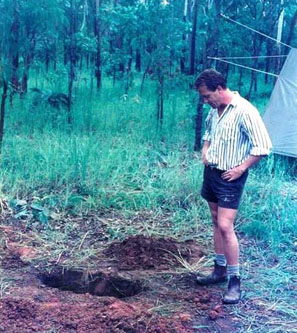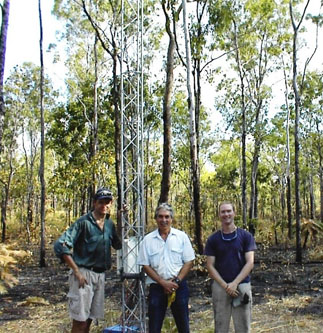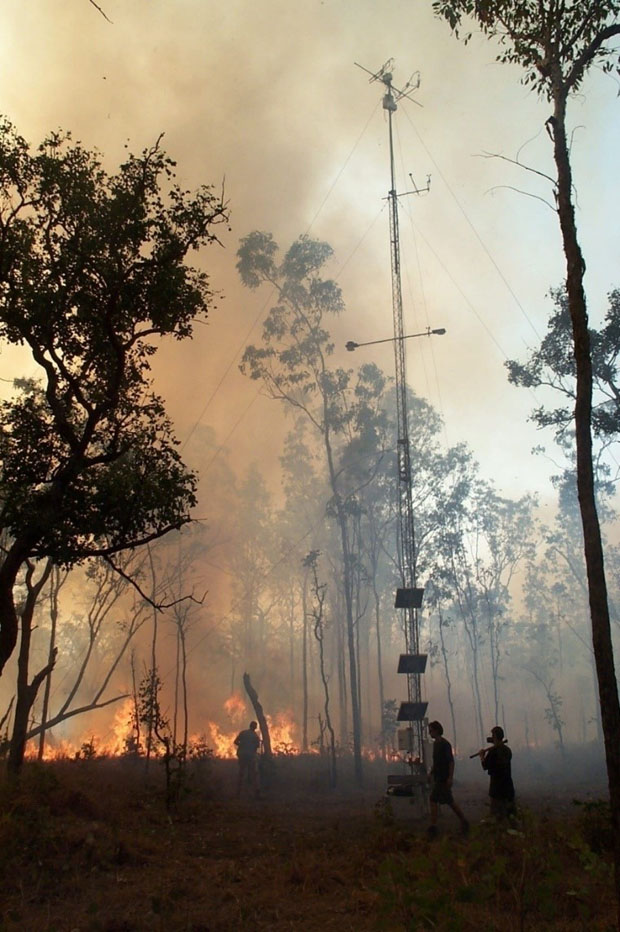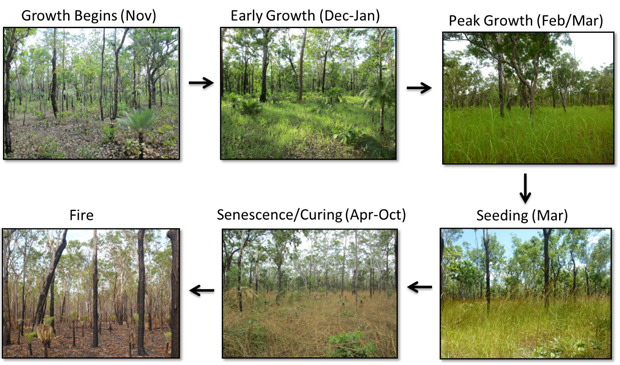
For this month's site feature, we're headed to the top of the Northern Territory where one of Australia's longest running ecosystem flux monitoring stations is located. The Howard Springs OzFlux site has been operating continuously since 2001, diligently capturing carbon, water and energy exchanges from Australia's productive, extensive and ecologically important tropical savanna ecosystems.
This year Howard Springs celebrates its 20th birthday – though the first initial EC measurements were undertaken in October 1996 – so this month's story is a celebration of the extensive work that has been enabled by this historic flux tower.
The site was established by ProfessorDerek Eamus  (University of Technology Sydney) and is now jointly managed by Professor Lindsay Hutley
(University of Technology Sydney) and is now jointly managed by Professor Lindsay Hutley  at Charles Darwin University and OzFlux Director Professor Jason Beringer
at Charles Darwin University and OzFlux Director Professor Jason Beringer  from The University of Western Australia. Alongside Lindsay and Jason, Matthew Northwood, also at Charles Darwin University, has been instrumental in keeping Howard Springs running for more than half of its life.
from The University of Western Australia. Alongside Lindsay and Jason, Matthew Northwood, also at Charles Darwin University, has been instrumental in keeping Howard Springs running for more than half of its life.
Pioneering work from the early years at Howard Springs
The Howard Springs is located in a wet-dry mesic savanna ecosystem that is representative of most of the top-end of continental Australia. Rainfall is highly seasonal in the savannas, with approximately 90 % of the mean annual rainfall of 1732 mm falling in the wet season months of October to April. This wet-dry dynamic has helped shape the savanna vegetation, which represents a co-existence between trees and grasses.
Investigations of the savanna ecosystem at Howard Springs began in the 1990s, where the fraction of ground water use by these evergreen Eucalypts was of critical importance for the sustainable use of the region's groundwater resource. This was pioneering work led by Prof. Derek Eamus in collaboration with CSIRO's Land and Water division and was one of the earliest studies  using eddy covariance methods in a water resource management context.
using eddy covariance methods in a water resource management context.
Canopy scale work was complimented by a raft of studies examining the ecophysiological traits of the site's different tree species  , including photosynthesis
, including photosynthesis  and leaf conductance
and leaf conductance  , leaf morphology
, leaf morphology  and leaf area index
and leaf area index  , root biomass
, root biomass  , transpiration
, transpiration  , and ecosystem carbon
, and ecosystem carbon  and water
and water  fluxes from a campaign-based flux tower used to measure seasonal fluxes.
fluxes from a campaign-based flux tower used to measure seasonal fluxes.
'I recall how hot the field work was – hasn't really changed' – Prof. Lindsay Hutley
The late 1990's and early 2000's saw the development of a collaboration with Profs Jason Beringer and Nigel Tapper which continues to this day. Resources from Monash University awarded though a 3-year ARC grant enabled the installation of a permanent flux tower in the dry season of 2001 that allowed for an investigation of the impact of fire on radiation, energy and carbon fluxes in the savanna using two temporary flux towers. One of these towers was earmarked as a permanent one that allowed for more detailed continuous investigation of the inter-annual variability in carbon dioxide and water fluxes from the savanna, as well as how fire impacted these fluxes over time.
'We had a vision for keeping a long term tower going but in the 10 years before TERN we run the tower from one small grant to the next with many weekends and student help to maintain a continuous record as best we could on the smell of an oily rag' – Prof. Jason Beringer
Tony O'Grady contemplates the hand dug hole for the Howard Springs tower anchors during the early seasonal flux campaigns, March 1998 (left, credit: Lindsay Hutley), Lindsay with Bert Tanner of Campbell Scientific and Lucas Cernusak at a 2nd tower at Howard Springs, July 2003 (right, credit: Lindsay Hutley).
Two decades of research reveals how climate and fire shapes savannas
As the years have ticked by at Howard Springs, the flux tower data and complementary research efforts have revealed the importance of climate and fire influencing physiological processes in Australia's tropical savanna ecosystems. The flux tower has been particularly vital in documenting the seasonality of carbon taken up by the highly productive trees, grasses and shrubs that make up the ecosystem, but also where along the way this carbon is lost from the system during the dry season and from the frequent fire.
The main culprit for carbon loss is through fires  , which are inevitable in savanna ecosystems – Howard Springs has a fire return rate of 1-3 years. Fires also impact on meteorological processes
, which are inevitable in savanna ecosystems – Howard Springs has a fire return rate of 1-3 years. Fires also impact on meteorological processes  like the summer monsoon, which can affect savanna evapotranspiration
like the summer monsoon, which can affect savanna evapotranspiration  . Less common disturbances are cyclones
. Less common disturbances are cyclones  , which can damage large swathes of savanna as they cut across the landscape, and termites
, which can damage large swathes of savanna as they cut across the landscape, and termites  , which consume plant biomass and release methane in the process. By 2021, we are still refining carbon balance, with recent work focussed on the carbon loss to the groundwater system, wetlands and the Howard River
, which consume plant biomass and release methane in the process. By 2021, we are still refining carbon balance, with recent work focussed on the carbon loss to the groundwater system, wetlands and the Howard River  .
.
'It became clear that long term measurements would be needed to characterize the long term Net Biome Production that takes into account the type, frequency and intensity of disturbance factors like fire, termites and cyclones' – Prof. Jason Beringer
Howard Springs became very well studied by the mid-2000's, but there were still questions unanswered about how representative the site was of savanna ecosystems across Australia, and how savanna structure and function changed along the rainfall gradient from Howard Springs to Alice Springs. In 2007, ARC funding enabled the extension of the work along CSIRO's North Australian Tropical Transect (NATT) in a massive field campaign called SPECIAL - Spatial Patterns of Energy and Carbon Integrated Across the Landscape. Seven additional sites were established along the 1000 mm rainfall gradient moving inland from Howard Springs, led by Jason, Lindsay, and with Dr. Peter Isaac  as the postdoc at the time. Howard Springs represents the northern-most site along this transect, providing a key piece in this new living laboratory
as the postdoc at the time. Howard Springs represents the northern-most site along this transect, providing a key piece in this new living laboratory  to study spatial patterns of vegetation change
to study spatial patterns of vegetation change  over a prominent rainfall gradient.
over a prominent rainfall gradient.
'It was extremely difficult in the early days to exclude fire so in recent years we fight fire with fire and a lot of effort is spent control burning' – Prof. Jason Beringer
Fighting fire with fire at Howard Springs (credit: Jason Beringer)
As Howard Springs entered its teen years, an understory tower was installed (in 2013) to quantify the contributions of trees and grasses  to savanna ecosystem productivity. At the peak of the wet season, the understory contributes almost 75 % of the productivity to the ecosystem. Much of this carbon returns to the atmosphere via the dry season fires.
to savanna ecosystem productivity. At the peak of the wet season, the understory contributes almost 75 % of the productivity to the ecosystem. Much of this carbon returns to the atmosphere via the dry season fires.
Seasonal changes in the understory at Howard Springs driven by plant life cycle traits, moisture availability and fire (Credit: Moore et al. 2016).
The future for Howard Springs
There is much to reflect on over 20 years of measurement from the Howard Springs site, and much still to learn about these iconic savanna ecosystems. In 2015, the TERN Litchfield Savanna SuperSite  joined Howard Springs in the Top End to provide complementary flux measurements in a similar savanna ecosystem zone. Recent analysis is showing a clear trend of CO2 fertilisation as the site's 20th anniversary approaches in August 2021, and the longer the site can continue, the power of the data collection increases.
joined Howard Springs in the Top End to provide complementary flux measurements in a similar savanna ecosystem zone. Recent analysis is showing a clear trend of CO2 fertilisation as the site's 20th anniversary approaches in August 2021, and the longer the site can continue, the power of the data collection increases.
'As we approach 20 years, we are seeing strong long term increases in carbon uptake at the site that is correlated with increased precipitation, growing season length and higher CO2 levels. New research is needed to understand the drivers (such as CO2 fertilisation) for this change, and land surface models will be needed to attribute the changes that we see' – Prof. Jason Beringer
'I reckon I can run the site even in my retirement' – Prof. Lindsay Hutley
Moving forward, it will be important to understand the role of climate change and disturbance (fire, cyclones, termites and invasive species and disease) on these systems and to grapple with complex interacting affects in the future.






